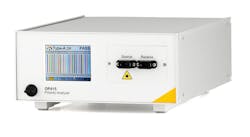September Special Report: Optical communications test
Download this article in .PDF format.
The optics are good
While 5G will undoubtedly do wonders for the massive amount of anticipated electronic devices in the next few years, the transmission speeds of its radio frequency-based wireless mobile technologies are limited by the available regulated RF spectrum.
Because of this, optical communications technology will remain a crucial counterpart to wireless RF, as considerable advancements in optical system capacity, network reach, and user base size make it an attractive commercial solution. Optical wireless communication (OWC) systems are attractive as a broadband access technology due to their high speeds, capacity, and the cost-effectiveness of meeting bandwidth requirements of different services and applications of next-generation networks. Optical wireless communications can also serve as an alternative or complementary technology for current wireless RF solutions.
OWCs’ applications range from broadband services to space missions, where their high bandwidth capacity enables scientists to send much more data to Earth than possible through RF. Also, the optical communications spectrum has not been regulated, so those creating technology with it don’t need to worry about available allocations. Last but not least, OWCs are considerably smaller, lighter, and consume less power than RF packages.
Gains in optical communications capacity comes primarily from three sources: increased spectrum efficiency via higher modulation density, higher symbol rate, and more carriers via techniques like polarization and multi-carrier orthogonal frequency-division multiplexing (OFDM) modulation.
Optical coherent transmission technology was originally used in long-haul transmissions, but now encompasses metropolitan networks and data center interconnects. Keysight’s application note goes on to say the key challenges in making measurements on coherent optical systems are in providing known, repeatable, clean, and distorted test signals at data rates above 32 GBd and with the flexibility to support diverse modulation formats.
To dive deeper into the topic of optical communications technology and the testing involved, we at Evaluation Engineering gathered input from several vendors about trends they’re seeing, challenges, customer needs, and what newer solutions are available. Here’s what they told us.
What’s trending?
What technology or market trends are vendors seeing in the area of optical communications test?Hiroshi Goto, business development manager at Anritsu Company: “Data center and network traffic volumes are increasing exponentially as 5G networks are rolled out and Big Data applications expand. The result is that physical-layer devices must accommodate ultra-high-speed data transmissions using technologies such as PAM4 to transport 100 Gbps per lane or per wavelength.”
Heike Tritschler, marketing segment lead - optical & electrical networking, and Pavel Zivny, domain expert - serial data measurements at Tektronix: “The optical test spans 26 GBd devices and 53 GBd devices, majority of them multiple lanes—up to eight lanes. This is a large number of devices/lanes to test.”
Challenges
What key challenges are optical communications test vendors or their partners facing today?Goto, Anritsu Co.: “The integration of 100 Gbps PAM4 data with Forward Error Correction (FEC) means that a new test metrology must be established. Test solutions need improved sensitivity to accurately analyze PAM4 signals because those signals automatically lose 10 dB optical signal-to-noise ratio (OSNR) compared to NRZ signals. In addition to ONSR, the signal integrity of PAM4 affects the eye closure of the PAM4 signal.”
Tritschler and Zivny, Tektronix: “The methodology changes, in particular the TDECQ test, came just at the same time as the big change in architecture (PAM4). This created a lot of uncertainty that has been worked through.”
What are customers asking for?
What features or innovations are customers asking for in optical communications test?Goto, Anritsu Co: “Engineers need a test solution that is simple to operate and can analyze and characterize PAM4 signals and data quickly. They also need instruments that can conduct optical stressed eye testing for 100 Gbps PAM4.”
Tritschler and Zivny, Tektronix: “Users need fast compliance testing on many channels; and users are asking for help interpreting the results.”
Areas of focus
Optical communications test spans applications from datacenters, to 5G-related networks, to photonic integrated circuits, and beyond. Here’s what vendors told us they’re focusing on.Goto, Anritsu Co.: “With our MP1900A, Anritsu is focused on verifying the design and manufacture of high-speed data center interconnects and backplanes such as active optical cable (AOC) and QSFP-DD optical modules. The MP1900A BERT supports high-speed computer bus interfaces, such as PCI Express 5.0 and USB 3.2, as well as next-generation 400G Ethernet communications interfaces.”
Tritschler and Zivny, Tektronix: “We see a lot of overlap in the key areas—datacenter attracts the PIC suppliers just as much as it does the traditional optics vendors. A new focus for us is the backhaul for 5G.”
Compliance/Regulatory
What recent or upcoming compliance, regulatory, or compatibility issues—if any—are impacting technology in optical communications test?Goto, Anritsu Co.: “IEEE 802.3bs (200GAUI-4 and 400GAUI-8), 802.3cd (CR4, KR4), and OIF-CEI-56G-VSR/MR/LR, OIF-CEI-112G-VSR address 100G PAM4 optical signal characterization, while InfiniBand Trade Association (IBTA) HDR establishes standards to verify 200G interconnects. Anritsu has been involved in industry associations and standards bodies, which has allowed the MP1900A to support standards-based specifications.”
Tritschler and Zivny, Tektronix: “Tektronix is participating in the work at the IEEE 802.3. As with any new technology, there is a learning cycle and this is impacts our direction. We see our work with IEEE as a very productive involvement, which is enabling rather than burdening our work.”
Now on the market
Here’s what vendors shared as newer solutions or accessories they’ve recently introduced in the area of optical communications test, and their key features.Keysight: “Our M8290A Optical Modulation Analyzer and High-Speed Digitizer is a flexible solution platform for 400G coherent devices and transmitter test. It incorporates a 92 GSa/s modular optical modulation analyzer and a 92 GSa/s 4-channel electrical digitizer. Besides these modules, an additional arbitrary waveform generator module up to 92 GSa/s, such as the M8196A, can be added to the same AXIe chassis. This setup results in a compact and flexible coherent test solution that can be used together with additional specialized solution software for Integrated Coherent Receiver (ICR) and Coherent Optical Device module characterization.”
Applications
What novel or unique applications have these vendors’ regenerative optical communications test solutions been used for recently?Goto, Anritsu: “The MP1900A has been used to generate a four-channel synchronized 100G PAM4 signal (53 GBd x 4 lanes) to support next-generation 50+ GBd applications, such as 400 GbE and CEI-112G.”
Tritschler and Zivny, Tektronix: “We have always enjoyed working with researchers on very high-speed testing, and our 80C10C optical module has consistently been used as a reference for 53 GBd and faster. We are working on very early experiments in 112 GBd with a selected partner. We will show more at the ECOC show (Sept. 23-25 in Dublin, Ireland).”
References
1. Keysight Technologies, “Coherent Optical Communications Test Challenges,” August 2017.
For more information
Anritsu Company
Tektronix
OptoTest
Teledyne LeCroy
Keysight Technologies
About the Author







